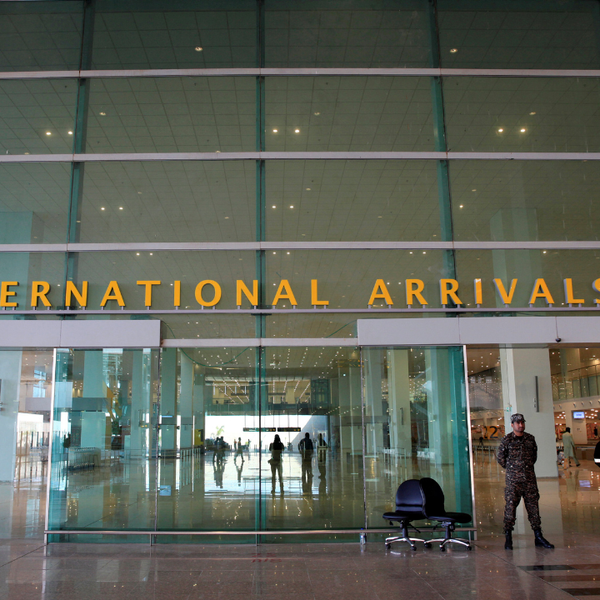Gulf central banks join Fed in slashing rates
The rate adjustments align with the Fed’s policy due to the Gulf currencies being pegged to the U.S. dollar

Rana Tabbara
Senior Business Producer
Rana Tabbara is a UAE-based reporter and content creator known for dynamic storytelling, impactful reporting, and high-profile interviews. She interviewed leaders including the UAE Minister of Energy, the Australian Prime Minister, the Saudi Minister of Tourism, the Armenian Minister of Economy, and CEOs of major companies. Rana covered big events like the World Government Summit, LEAP, Cityscape KSA, IDEX, among others. Her previous experiences include The New York Times, CNN Business Arabic, and L'Orient-Le Jour.

GCC central banks reduce rates in line with the Fed's 50 basis point cut
Shutterstock
Most central banks in the Gulf region have reduced their benchmark interest rates, following the U.S. Federal Reserve’s decision to cut rates for the first time in over a year.
The Fed lowered its rates by 50 basis points to a range of 4.75% to 5%, signaling the start of a new monetary easing cycle to stave off a potential recession and ensure a soft landing for the U.S. economy. This move comes after maintaining the highest rates in 23 years for over a year to combat inflation, which had cooled economic growth.
Fed Chairman Jerome Powell noted that the labor market had eased from its overheated state and inflation had significantly decreased. He emphasized that the policy shift would help maintain labor market strength and support progress toward achieving a 2% inflation target.
GCC central banks follow suit
In response to the Fed's decision, Gulf central banks adjusted their rates accordingly:
- The Saudi Central Bank (SAMA) reduced its repo rate by 50 basis points to 5.5% and its reverse repo rate to 5%.
- The UAE Central Bank cut its base rate for the Overnight Deposit Facility (ODF) by 50 basis points to 4.90% and maintained short-term borrowing rates at 50 basis points above the base rate.
- The Central Bank of Bahrain lowered its key rate on overnight deposits by 50 basis points to 5.5%.
- The Central Bank of Kuwait reduced its discount rate by 25 basis points to 4%.
- Qatar’s Central Bank adjusted its rates, reducing the deposit rate to 5.2% and the lending rate to 5.7%, while raising the repo rate to 5.45%.
These rate adjustments align with the Fed’s policy due to the Gulf currencies being pegged to the U.S. dollar, except for Kuwait’s dinar, which is linked to a basket of currencies. This synchronization persisted through the Fed’s aggressive rate hike cycle despite lower inflation in the oil-rich GCC economies.
Economic outlook and implications
The Fed’s larger-than-expected rate cut reflects an urgency to address growth concerns. This move, while largely anticipated, is likely to temporarily weaken the U.S. dollar and provide a boost to asset markets.
The reduction in rates is expected to alleviate financing costs for large-scale diversification projects in the GCC, where economies are more influenced by oil prices than monetary policy alone.
Countries like Saudi Arabia and the UAE are undertaking tens of billions of dollars worth of projects to diversify their economies, part-financed by government equity, commercial financing, and project bonds.
The UAE economy, which has maintained strong growth momentum since 2022, saw a 3.4% GDP increase in the first quarter of this year, driven by a 4% rise in the non-oil sector.
The Central Bank of the UAE expects the economy to grow by 3.9% this year and accelerate to 6.2% in 2025, as Opec gradually eases oil production cuts.
Inflation dynamics
Inflation in the UAE is projected to rise to 2.3% this year from 1.6% last year, due to moderate increases in commodity prices, wages, and rents. In Saudi Arabia, inflation is expected to decline to 1.9% by the end of the year from 2.3% in 2022.
Globally, inflation is predicted to decrease steadily, with the International Monetary Fund (IMF) forecasting a drop from 6.8% last year to 5.9% in 2024 and 4.5% in 2025. In the U.S., inflation has come down to 2.4% in August, close to the Fed’s target, after reaching a four-decade high of 9.1% in June 2022.
The high-interest environment aimed at curbing both inflation and job growth has raised concerns about a potential recession.
JP Morgan Chase estimates a 35% probability of a U.S. and global recession by the end of 2024, with the likelihood of a recession by the end of 2025 remaining at 45%.
Market reactions and future prospects
The Fed's decision has led to a rally in U.S. stocks, a decline in the dollar to a one-year low, and a surge in gold prices to a new high of $2,591.19 per ounce.
The GCC economies, poised for a strong rebound in 2025 with projected growth of 4.4%, are expected to benefit from the reversal of Opec+ oil production cuts and continued strength in non-oil sectors such as tourism, trade, and finance. This resilience positions the region for sustained success amid global economic uncertainty.







Comments
See what people are discussing